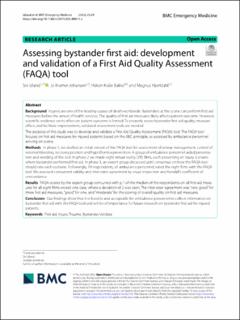| dc.description.abstract | Background Injuries are one of the leading causes of death worldwide. Bystanders at the scene can perform first aid
measures before the arrival of health services. The quality of first aid measures likely affects patient outcome. However,
scientific evidence on its effect on patient outcome is limited. To properly assess bystander first aid quality, measure
effect, and facilitate improvement, validated assessment tools are needed.
The purpose of this study was to develop and validate a First Aid Quality Assessment (FAQA) tool. The FAQA tool
focuses on first aid measures for injured patients based on the ABC‑principle, as assessed by ambulance personnel
arriving on scene.
Methods In phase 1, we drafted an initial version of the FAQA tool for assessment of airway management, control of
external bleeding, recovery position and hypothermia prevention. A group of ambulance personnel aided presenta‑
tion and wording of the tool. In phase 2 we made eight virtual reality (VR) films, each presenting an injury scenario
where bystander performed first aid. In phase 3, an expert group discussed until consensus on how the FAQA tool
should rate each scenario. Followingly, 19 respondents, all ambulance personnel, rated the eight films with the FAQA
tool. We assessed concurrent validity and inter‑rater agreement by visual inspection and Kendall’s coefficient of
concordance.
Results FAQA‑scores by the expert group concurred with ± 1 of the median of the respondents on all first aid meas‑
ures for all eight films except one case, where a deviation of 2 was seen. The inter‑rater agreement was “very good” for
three first aid measures, “good” for one, and “moderate” for the scoring of overall quality on first aid measures.
Conclusion Our findings show that it is feasible and acceptable for ambulance personnel to collect information on
bystander first aid with the FAQA tool and will be of importance for future research on bystander first aid for injured
patients | en_US |

